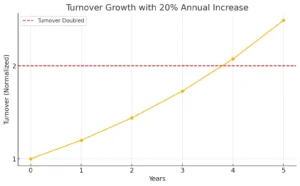
For small and medium-sized businesses, sustainable growth is more than just a goal—it’s a necessity for long-term success. While many organizations dream of explosive growth, aiming for a steady 20% annual increase in revenue offers a strategic advantage. Research supports the idea that moderate, sustainable growth is often more beneficial for SMBs than rapid expansion. Here’s why:
Supporting Research:
Davidsson et al. (2009) found that SMBs are more likely to achieve high growth and high profitability when starting from a position of stability and sound management rather than prioritizing rapid growth at the expense of infrastructure and operational readiness.
Supporting Research:
Brännback et al. (2009) confirmed that firms typically do not grow into profitability but achieve profitable growth by maintaining profitability at smaller scales. Doubling turnover at a measured pace ensures long-term financial health.
Illustration:
A steady 20% annual growth leads to turnover doubling every 4-5 years. The graph below demonstrates this concept, showcasing how sustainable growth compounds over time.

“Figure 1: The steady growth of turnover at a 20% annual increase demonstrates how revenue doubles in just 4-5 years, showcasing the power of sustainable growth.”
Supporting Research:
Customer retention and loyalty often align with moderate growth strategies, as businesses with steady expansion invest more in customer relationships and satisfaction, ensuring lasting partnerships.
Supporting Research:
Davidsson et al. (2009) highlight that firms pursuing moderate growth are more resilient, as they balance profitability and investment without over-leveraging resources.
Supporting Research:
Strategic growth creates opportunities for SMBs to innovate and capture market share without sacrificing quality or brand integrity, according to Brännback et al. (2009).
Supporting Research:
Organizational culture is preserved more effectively in firms that adopt moderate growth strategies, as leaders and employees have time to align with the company’s evolving goals and values.
Achieving 20% growth year over year might not sound as exciting as explosive growth, but for SMBs, it is the sweet spot. This pace allows businesses to develop their organization, double their turnover every 4-5 years, and create a foundation of customer retention and loyalty. More importantly, it positions them for sustainable success in an ever-changing business landscape.
By prioritizing steady, deliberate growth and learning from research-backed strategies, SMBs can thrive without compromising their values, financial stability, or market reputation.
Davidsson, P., Steffens, P., & Fitzsimmons, J. (2009). “Growing Profitable or Growing from Profits: Putting the Horse in Front of the Cart?” Journal of Business Venturing, 24(4), 388–406.
Brännback, M., Carsrud, A., & Renko, M. (2009). “Growth and Profitability in Small Privately Held Biotech Firms: Preliminary Findings.” New Biotechnology, 25(5), 369–376.


